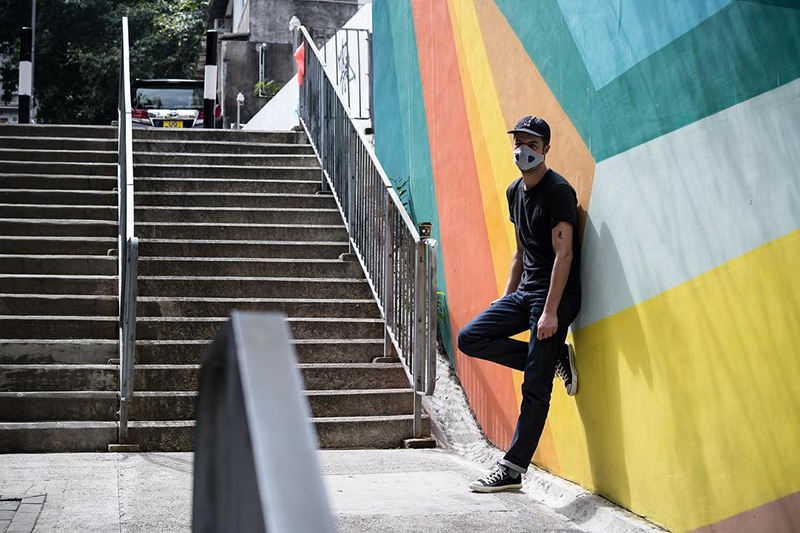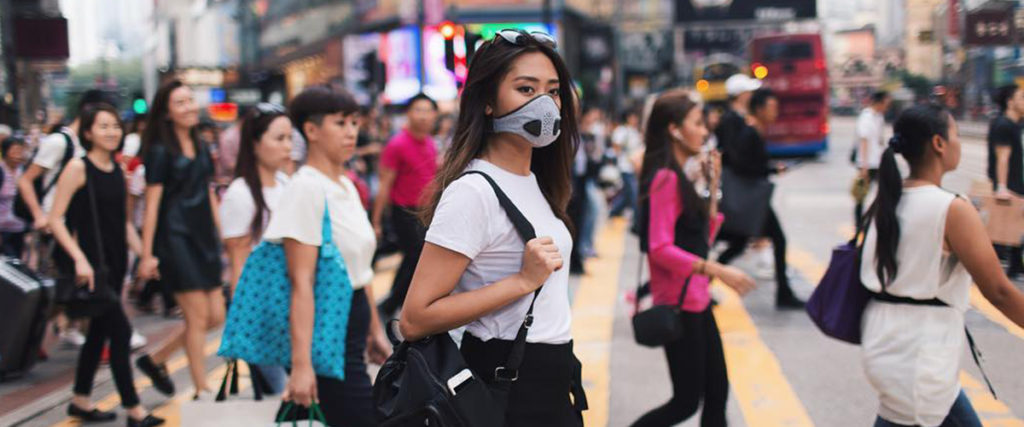Meet the entrepreneurs trying to make anti-pollution masks effective, comfortable and stylish. The founders of Akmon, they’re doing their part to raise awareness about what you’re really breathing into your lungs.
Walking around Hong Kong, visibility can be limited to around eight kilometres around 30% of the year, thanks to air pollution. And it’s a problem going nowhere. Just a few months ago, the Pearl River Delta Regional Air Quality Monitoring Network recorded average ozone concentrations at 58 micrograms per cubic metre, the highest since 2011. “With such pollution levels, when you do a Q-tip test on your forehead at night when you get back home, you can find black substances,” says Clément Poch, Co-Creator of Hong Kong-based anti-pollution mask brand Akmon. “The economic reality of air pollution is that it’s going to take time to change. We can’t just say, stop burning coal and use 100% clean energy altogether, but we can all do our part.”

For Clément and his business partner Paul Zaher, the part they want to play lies in helping mitigate the risks of pollution whilst people go about their daily lives. “Dealing with pollution comes from realising it. For us, this awareness all started when Paul and I were inhaling all that black smoke and pollution in traffic every day on our motorcycles. The anti-pollution masks we tried didn’t work out. Some had lots of leakage on the sides. Some didn’t filter out pollution properly. So we thought, why not try making our own product? All great companies come from personal needs and wants and our need for a mask to deal with air pollution meant that the first customers of Akmon were ourselves.” With other models already in existence, ranging from low-fi, disposable options to full-on face masks, the pair wanted to create a product that stood out. “It took over two years of research and development working with a German engineering firm, PDD, to design the valves and filters, and French designers with the types and styles of fabrics, to get a product we were happy with distributing,” he explains. Today, their masks come in nine colours and are used by anyone ranging from delivery drivers to everyday pedestrians, to hotel groups such as the Four Seasons, which sells them to tourists in their hotels in Japan, India and mainland China.
You might also like Breaking Down Biohacking: Silicon Valley’s Hottest New Health Craze
“We really wanted to do something no one out there had ever done before with these masks, that are convenient to everyday life, can also be a fashion accessory, and can be used on a daily basis,” Clément explains. Akmon prides itself on its cup-shaped filters that allow for greater comfort, and a unique valve system which ensures unfiltered air is kept out, as well as 95% of harmful pollutants. The designs are also interchangeable with users able to buy replacement filters and valves where necessary, making them more environmentally friendly than the usual disposable ones seen around town. And, finally, the duo considers their rayon, nylon and spandex design to be one of the most aesthetic masks on the market. “Most of our competitors market these masks as some last resort to a post-apocalyptic world. Some of the ones we tried made us look like Jason Voorhees from Friday the 13th,” laughs Clément. “Our masks are never going to be the sexiest products, but we wanted to make them as good-looking as possible. Yes, pollution is terrible, but dealing with it shouldn’t compromise your daily life.”

Keen to position themselves as well as possible in the vastly growing industry of green consumer goods, each purchase of an Akmon mask contributes to the planting of a tree in Africa, Asia or America, ensuring a positive, two-fold contribution to the ecosystem. It’s innovative moves such as this that they see as vital for growth. “We’re all about positive marketing and progress. We have a second design in the pipeline that’s more suited to sports with lighter, breathable materials, and another mask that can connect to your phone and pull data to see how much polluted air you’ve stopped getting into your lungs and when you need to change your filter. You’ll have to wait at least a year for that though!”
Related Articles
But First, No More Stigma: Curing Hong Kong’s Mental Illness Epidemic
Australian Tech Firm Removify Helps Businesses Fight Fake News





